Business Management: Functions, Supervision, HR, and Talent Analysis
VerifiedAdded on 2023/06/11
|8
|2028
|395
Report
AI Summary
This report provides an overview of business management, focusing on business functions, supervision arrangements, and the interrelationship between Henry Fayol's five functions of management: planning, organizing, commanding, coordinating, and controlling. It highlights the importance of marketing, HR, and talent management within an organization. The report also discusses various management theories, including scientific, administrative, system, contingency, and Theory X and Y, and examines different organizational structures such as divisional, functional, matrix, networking, and team structures. The conclusion emphasizes the significance of effective management in enhancing organizational performance and achieving business goals. This document is available on Desklib, a platform offering a range of study tools and resources for students.
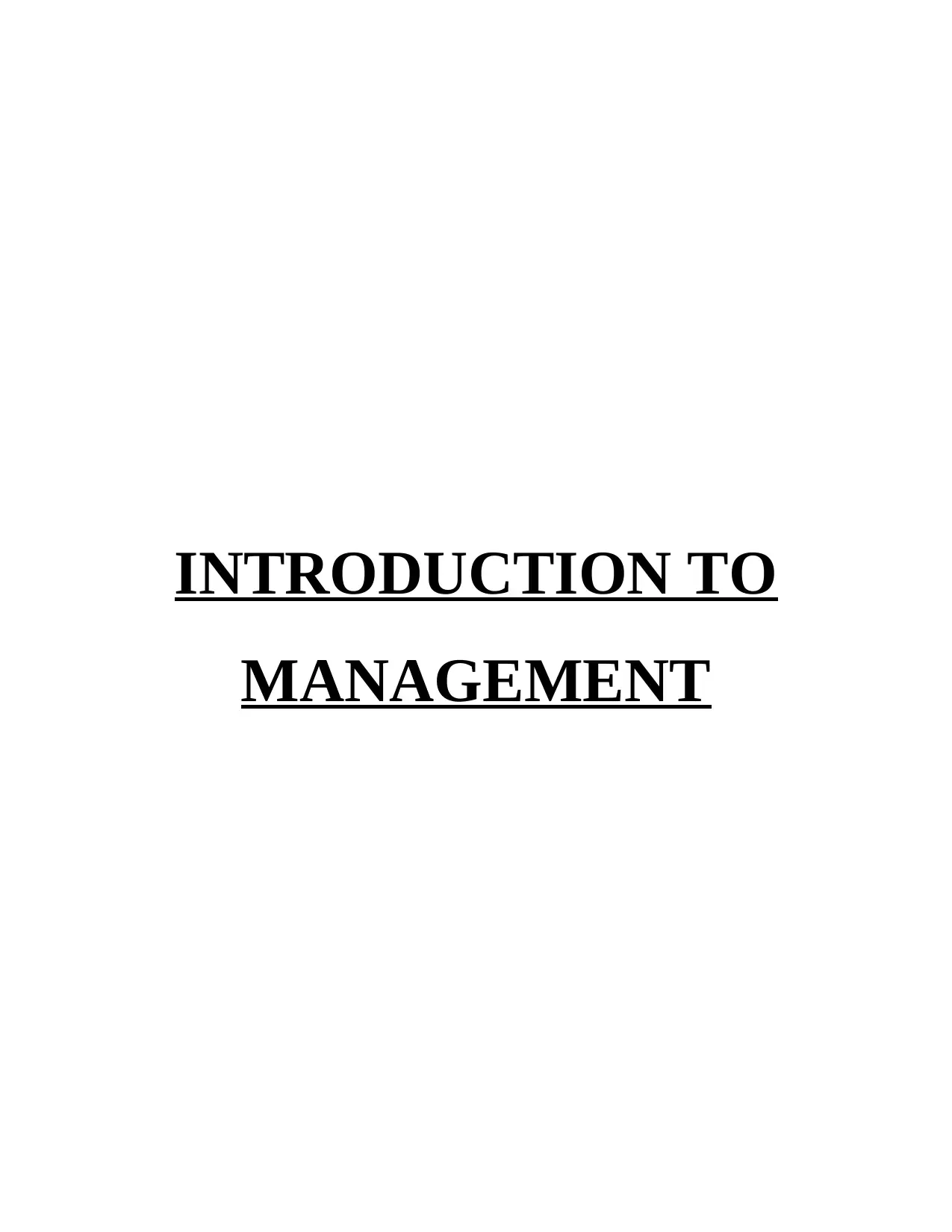
INTRODUCTION TO
MANAGEMENT
MANAGEMENT
Paraphrase This Document
Need a fresh take? Get an instant paraphrase of this document with our AI Paraphraser
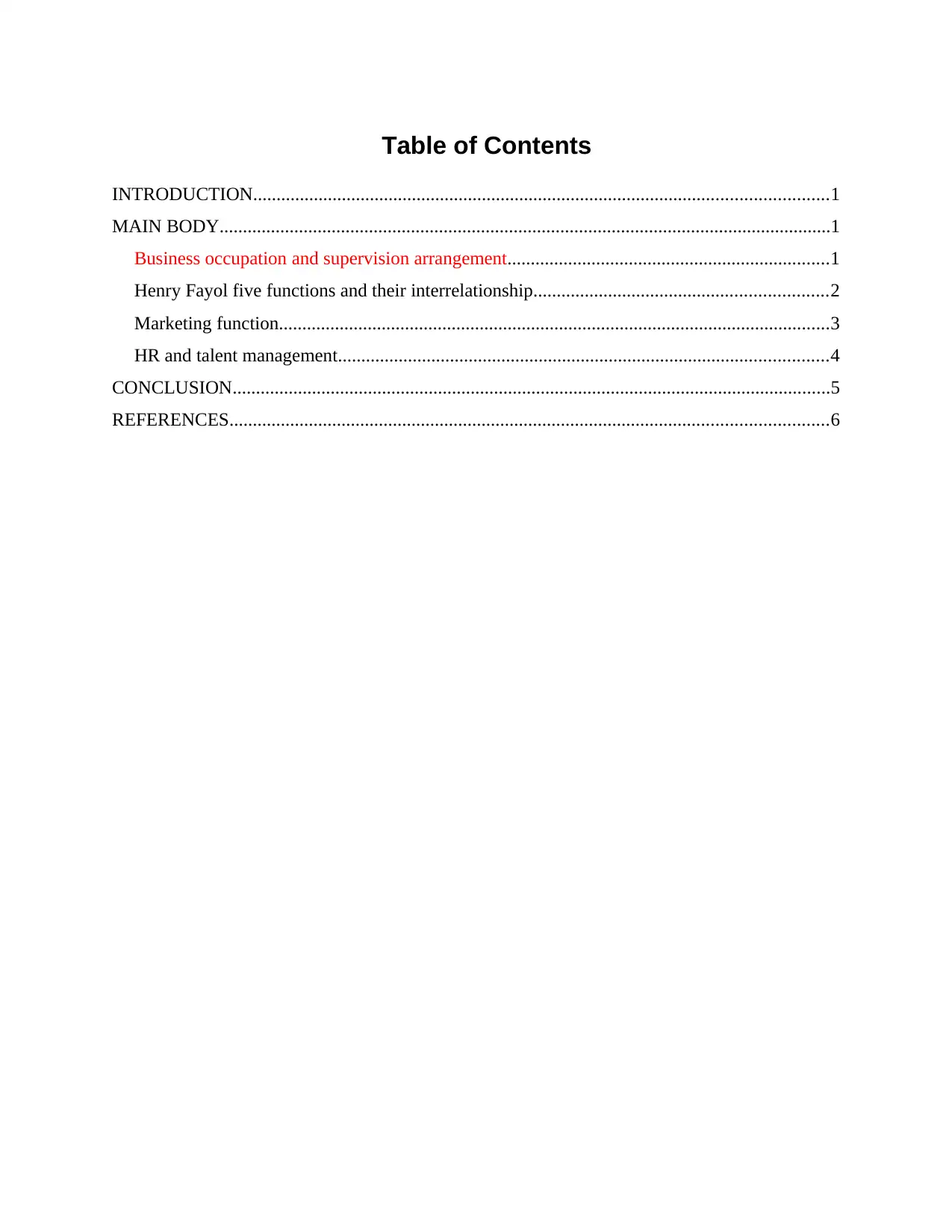
Table of Contents
INTRODUCTION...........................................................................................................................1
MAIN BODY...................................................................................................................................1
Business occupation and supervision arrangement.....................................................................1
Henry Fayol five functions and their interrelationship...............................................................2
Marketing function......................................................................................................................3
HR and talent management.........................................................................................................4
CONCLUSION................................................................................................................................5
REFERENCES................................................................................................................................6
INTRODUCTION...........................................................................................................................1
MAIN BODY...................................................................................................................................1
Business occupation and supervision arrangement.....................................................................1
Henry Fayol five functions and their interrelationship...............................................................2
Marketing function......................................................................................................................3
HR and talent management.........................................................................................................4
CONCLUSION................................................................................................................................5
REFERENCES................................................................................................................................6
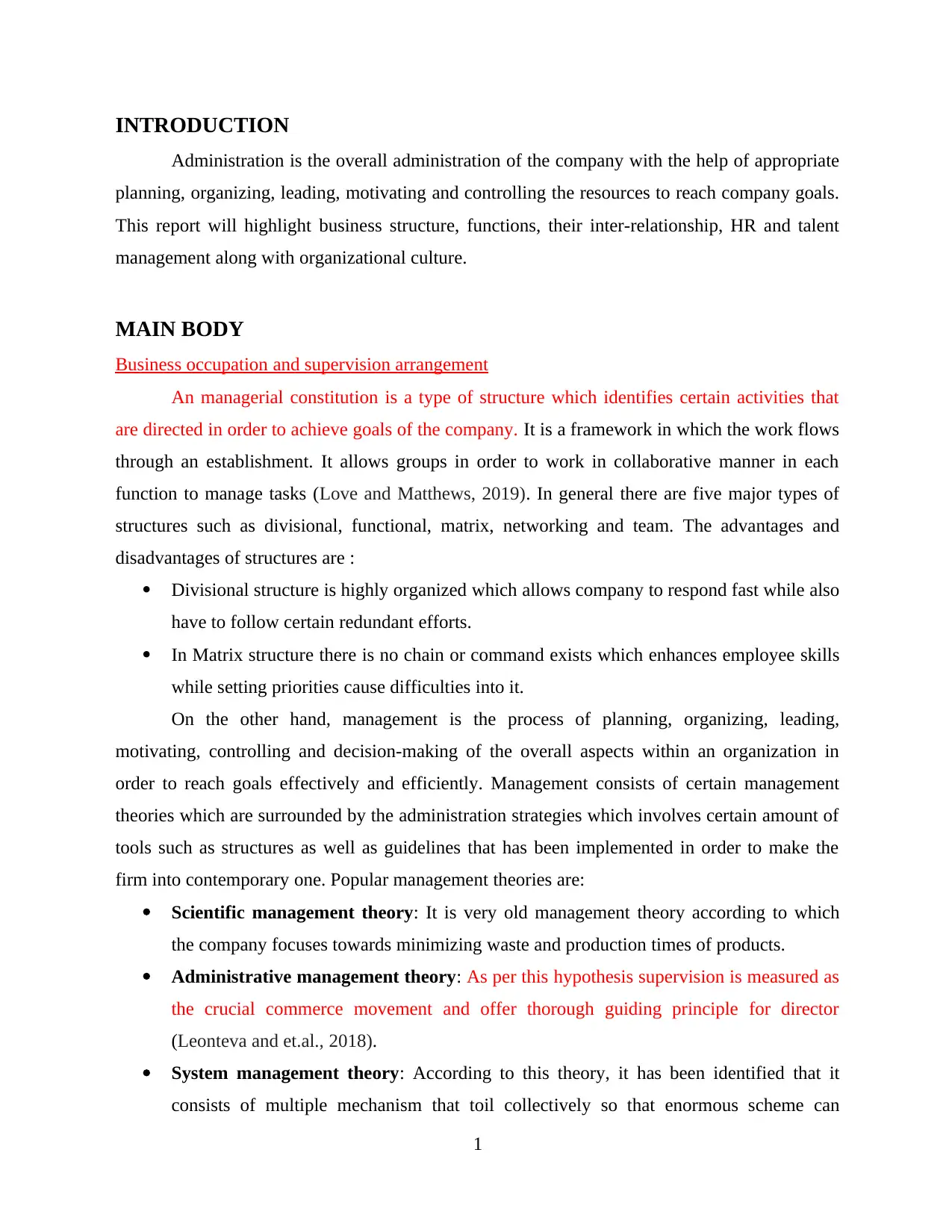
INTRODUCTION
Administration is the overall administration of the company with the help of appropriate
planning, organizing, leading, motivating and controlling the resources to reach company goals.
This report will highlight business structure, functions, their inter-relationship, HR and talent
management along with organizational culture.
MAIN BODY
Business occupation and supervision arrangement
An managerial constitution is a type of structure which identifies certain activities that
are directed in order to achieve goals of the company. It is a framework in which the work flows
through an establishment. It allows groups in order to work in collaborative manner in each
function to manage tasks (Love and Matthews, 2019). In general there are five major types of
structures such as divisional, functional, matrix, networking and team. The advantages and
disadvantages of structures are :
Divisional structure is highly organized which allows company to respond fast while also
have to follow certain redundant efforts.
In Matrix structure there is no chain or command exists which enhances employee skills
while setting priorities cause difficulties into it.
On the other hand, management is the process of planning, organizing, leading,
motivating, controlling and decision-making of the overall aspects within an organization in
order to reach goals effectively and efficiently. Management consists of certain management
theories which are surrounded by the administration strategies which involves certain amount of
tools such as structures as well as guidelines that has been implemented in order to make the
firm into contemporary one. Popular management theories are:
Scientific management theory: It is very old management theory according to which
the company focuses towards minimizing waste and production times of products.
Administrative management theory: As per this hypothesis supervision is measured as
the crucial commerce movement and offer thorough guiding principle for director
(Leonteva and et.al., 2018).
System management theory: According to this theory, it has been identified that it
consists of multiple mechanism that toil collectively so that enormous scheme can
1
Administration is the overall administration of the company with the help of appropriate
planning, organizing, leading, motivating and controlling the resources to reach company goals.
This report will highlight business structure, functions, their inter-relationship, HR and talent
management along with organizational culture.
MAIN BODY
Business occupation and supervision arrangement
An managerial constitution is a type of structure which identifies certain activities that
are directed in order to achieve goals of the company. It is a framework in which the work flows
through an establishment. It allows groups in order to work in collaborative manner in each
function to manage tasks (Love and Matthews, 2019). In general there are five major types of
structures such as divisional, functional, matrix, networking and team. The advantages and
disadvantages of structures are :
Divisional structure is highly organized which allows company to respond fast while also
have to follow certain redundant efforts.
In Matrix structure there is no chain or command exists which enhances employee skills
while setting priorities cause difficulties into it.
On the other hand, management is the process of planning, organizing, leading,
motivating, controlling and decision-making of the overall aspects within an organization in
order to reach goals effectively and efficiently. Management consists of certain management
theories which are surrounded by the administration strategies which involves certain amount of
tools such as structures as well as guidelines that has been implemented in order to make the
firm into contemporary one. Popular management theories are:
Scientific management theory: It is very old management theory according to which
the company focuses towards minimizing waste and production times of products.
Administrative management theory: As per this hypothesis supervision is measured as
the crucial commerce movement and offer thorough guiding principle for director
(Leonteva and et.al., 2018).
System management theory: According to this theory, it has been identified that it
consists of multiple mechanism that toil collectively so that enormous scheme can
1
⊘ This is a preview!⊘
Do you want full access?
Subscribe today to unlock all pages.

Trusted by 1+ million students worldwide
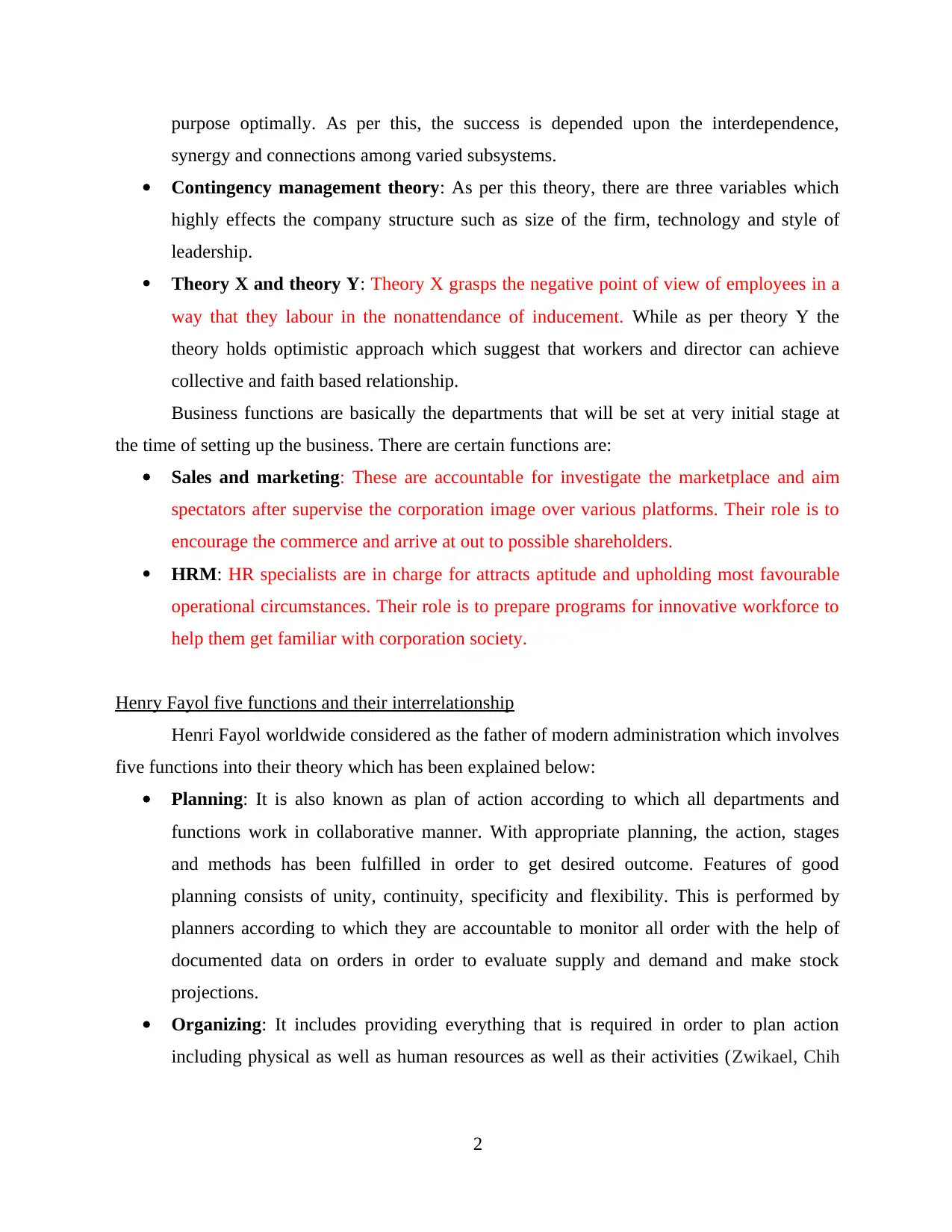
purpose optimally. As per this, the success is depended upon the interdependence,
synergy and connections among varied subsystems.
Contingency management theory: As per this theory, there are three variables which
highly effects the company structure such as size of the firm, technology and style of
leadership.
Theory X and theory Y: Theory X grasps the negative point of view of employees in a
way that they labour in the nonattendance of inducement. While as per theory Y the
theory holds optimistic approach which suggest that workers and director can achieve
collective and faith based relationship.
Business functions are basically the departments that will be set at very initial stage at
the time of setting up the business. There are certain functions are:
Sales and marketing: These are accountable for investigate the marketplace and aim
spectators after supervise the corporation image over various platforms. Their role is to
encourage the commerce and arrive at out to possible shareholders.
HRM: HR specialists are in charge for attracts aptitude and upholding most favourable
operational circumstances. Their role is to prepare programs for innovative workforce to
help them get familiar with corporation society.
Henry Fayol five functions and their interrelationship
Henri Fayol worldwide considered as the father of modern administration which involves
five functions into their theory which has been explained below:
Planning: It is also known as plan of action according to which all departments and
functions work in collaborative manner. With appropriate planning, the action, stages
and methods has been fulfilled in order to get desired outcome. Features of good
planning consists of unity, continuity, specificity and flexibility. This is performed by
planners according to which they are accountable to monitor all order with the help of
documented data on orders in order to evaluate supply and demand and make stock
projections.
Organizing: It includes providing everything that is required in order to plan action
including physical as well as human resources as well as their activities (Zwikael, Chih
2
synergy and connections among varied subsystems.
Contingency management theory: As per this theory, there are three variables which
highly effects the company structure such as size of the firm, technology and style of
leadership.
Theory X and theory Y: Theory X grasps the negative point of view of employees in a
way that they labour in the nonattendance of inducement. While as per theory Y the
theory holds optimistic approach which suggest that workers and director can achieve
collective and faith based relationship.
Business functions are basically the departments that will be set at very initial stage at
the time of setting up the business. There are certain functions are:
Sales and marketing: These are accountable for investigate the marketplace and aim
spectators after supervise the corporation image over various platforms. Their role is to
encourage the commerce and arrive at out to possible shareholders.
HRM: HR specialists are in charge for attracts aptitude and upholding most favourable
operational circumstances. Their role is to prepare programs for innovative workforce to
help them get familiar with corporation society.
Henry Fayol five functions and their interrelationship
Henri Fayol worldwide considered as the father of modern administration which involves
five functions into their theory which has been explained below:
Planning: It is also known as plan of action according to which all departments and
functions work in collaborative manner. With appropriate planning, the action, stages
and methods has been fulfilled in order to get desired outcome. Features of good
planning consists of unity, continuity, specificity and flexibility. This is performed by
planners according to which they are accountable to monitor all order with the help of
documented data on orders in order to evaluate supply and demand and make stock
projections.
Organizing: It includes providing everything that is required in order to plan action
including physical as well as human resources as well as their activities (Zwikael, Chih
2
Paraphrase This Document
Need a fresh take? Get an instant paraphrase of this document with our AI Paraphraser
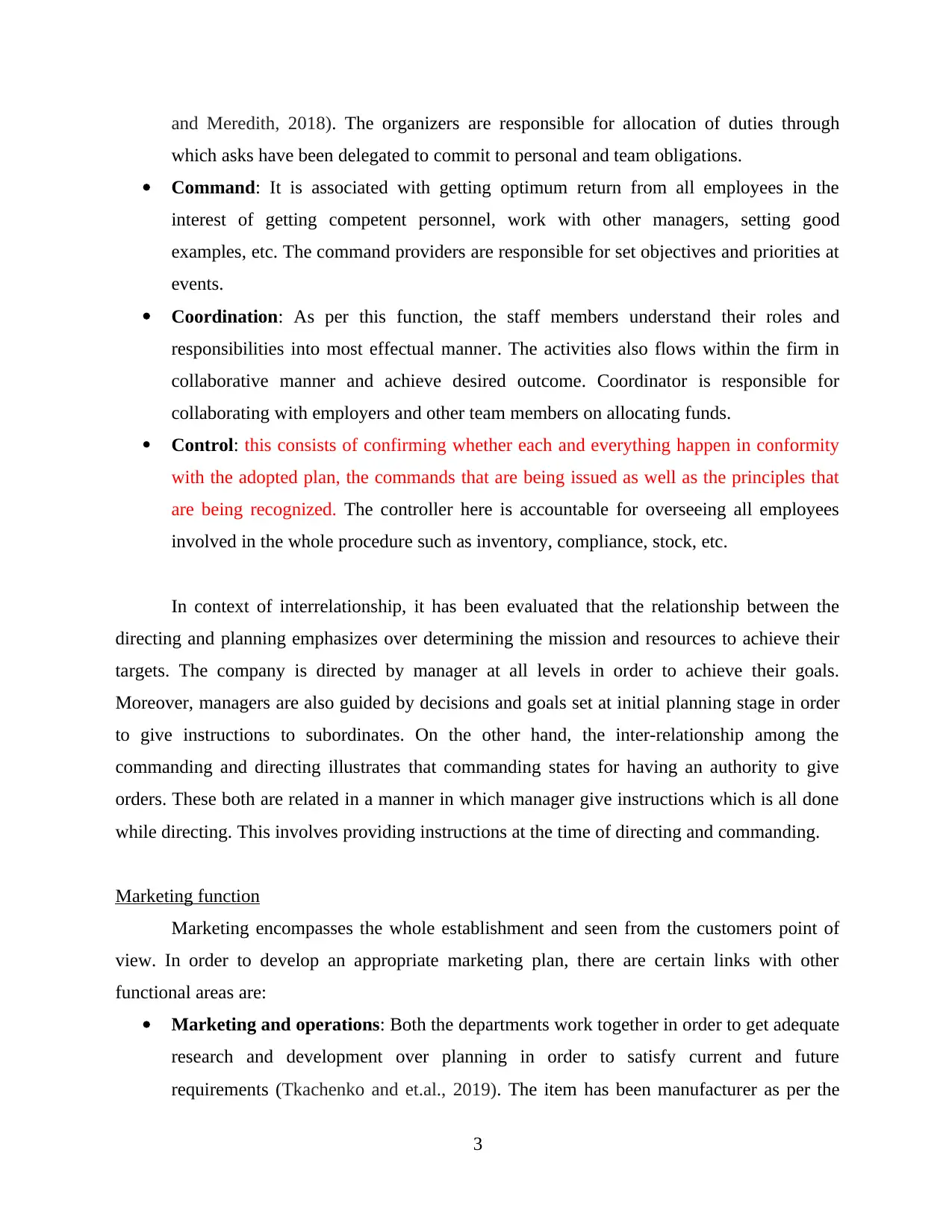
and Meredith, 2018). The organizers are responsible for allocation of duties through
which asks have been delegated to commit to personal and team obligations.
Command: It is associated with getting optimum return from all employees in the
interest of getting competent personnel, work with other managers, setting good
examples, etc. The command providers are responsible for set objectives and priorities at
events.
Coordination: As per this function, the staff members understand their roles and
responsibilities into most effectual manner. The activities also flows within the firm in
collaborative manner and achieve desired outcome. Coordinator is responsible for
collaborating with employers and other team members on allocating funds.
Control: this consists of confirming whether each and everything happen in conformity
with the adopted plan, the commands that are being issued as well as the principles that
are being recognized. The controller here is accountable for overseeing all employees
involved in the whole procedure such as inventory, compliance, stock, etc.
In context of interrelationship, it has been evaluated that the relationship between the
directing and planning emphasizes over determining the mission and resources to achieve their
targets. The company is directed by manager at all levels in order to achieve their goals.
Moreover, managers are also guided by decisions and goals set at initial planning stage in order
to give instructions to subordinates. On the other hand, the inter-relationship among the
commanding and directing illustrates that commanding states for having an authority to give
orders. These both are related in a manner in which manager give instructions which is all done
while directing. This involves providing instructions at the time of directing and commanding.
Marketing function
Marketing encompasses the whole establishment and seen from the customers point of
view. In order to develop an appropriate marketing plan, there are certain links with other
functional areas are:
Marketing and operations: Both the departments work together in order to get adequate
research and development over planning in order to satisfy current and future
requirements (Tkachenko and et.al., 2019). The item has been manufacturer as per the
3
which asks have been delegated to commit to personal and team obligations.
Command: It is associated with getting optimum return from all employees in the
interest of getting competent personnel, work with other managers, setting good
examples, etc. The command providers are responsible for set objectives and priorities at
events.
Coordination: As per this function, the staff members understand their roles and
responsibilities into most effectual manner. The activities also flows within the firm in
collaborative manner and achieve desired outcome. Coordinator is responsible for
collaborating with employers and other team members on allocating funds.
Control: this consists of confirming whether each and everything happen in conformity
with the adopted plan, the commands that are being issued as well as the principles that
are being recognized. The controller here is accountable for overseeing all employees
involved in the whole procedure such as inventory, compliance, stock, etc.
In context of interrelationship, it has been evaluated that the relationship between the
directing and planning emphasizes over determining the mission and resources to achieve their
targets. The company is directed by manager at all levels in order to achieve their goals.
Moreover, managers are also guided by decisions and goals set at initial planning stage in order
to give instructions to subordinates. On the other hand, the inter-relationship among the
commanding and directing illustrates that commanding states for having an authority to give
orders. These both are related in a manner in which manager give instructions which is all done
while directing. This involves providing instructions at the time of directing and commanding.
Marketing function
Marketing encompasses the whole establishment and seen from the customers point of
view. In order to develop an appropriate marketing plan, there are certain links with other
functional areas are:
Marketing and operations: Both the departments work together in order to get adequate
research and development over planning in order to satisfy current and future
requirements (Tkachenko and et.al., 2019). The item has been manufacturer as per the
3
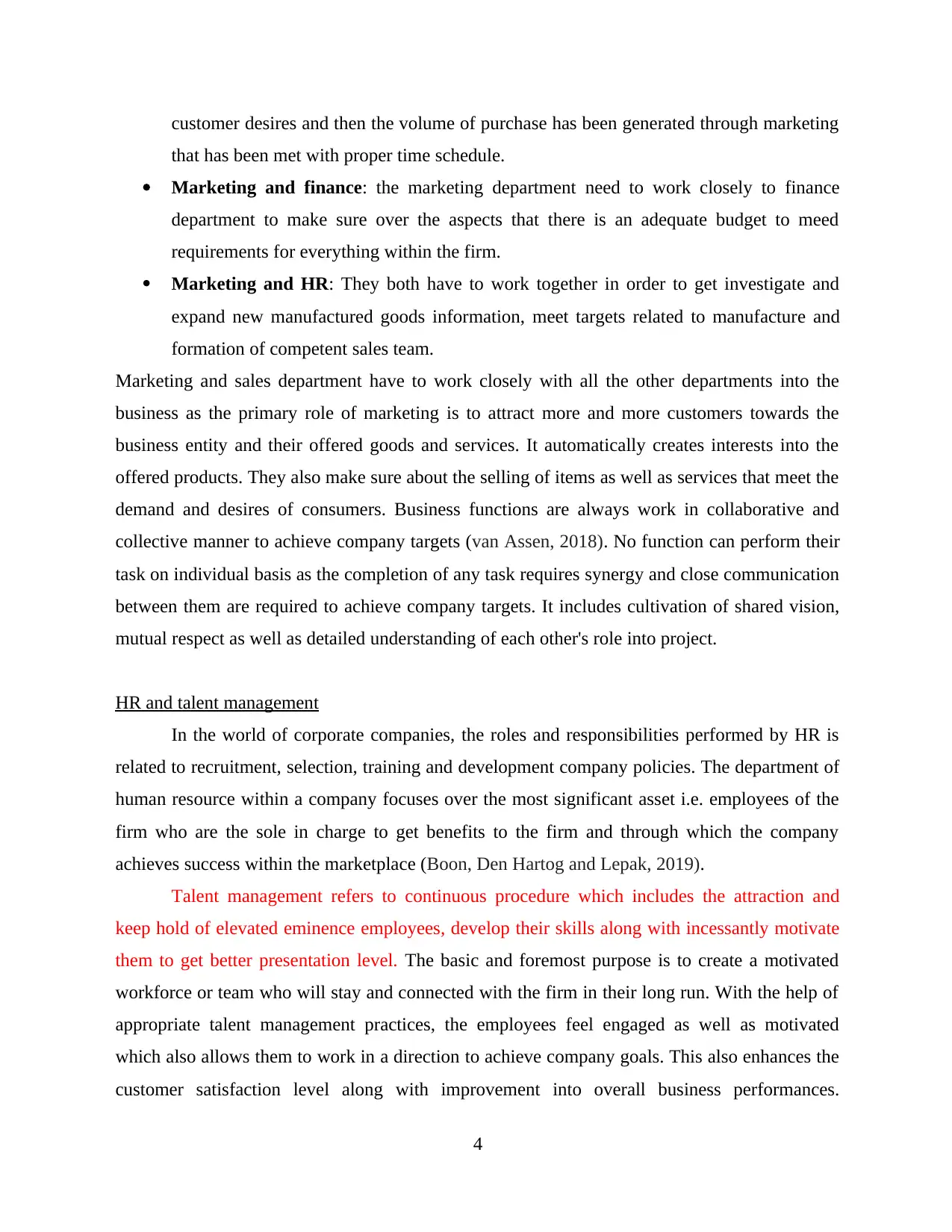
customer desires and then the volume of purchase has been generated through marketing
that has been met with proper time schedule.
Marketing and finance: the marketing department need to work closely to finance
department to make sure over the aspects that there is an adequate budget to meed
requirements for everything within the firm.
Marketing and HR: They both have to work together in order to get investigate and
expand new manufactured goods information, meet targets related to manufacture and
formation of competent sales team.
Marketing and sales department have to work closely with all the other departments into the
business as the primary role of marketing is to attract more and more customers towards the
business entity and their offered goods and services. It automatically creates interests into the
offered products. They also make sure about the selling of items as well as services that meet the
demand and desires of consumers. Business functions are always work in collaborative and
collective manner to achieve company targets (van Assen, 2018). No function can perform their
task on individual basis as the completion of any task requires synergy and close communication
between them are required to achieve company targets. It includes cultivation of shared vision,
mutual respect as well as detailed understanding of each other's role into project.
HR and talent management
In the world of corporate companies, the roles and responsibilities performed by HR is
related to recruitment, selection, training and development company policies. The department of
human resource within a company focuses over the most significant asset i.e. employees of the
firm who are the sole in charge to get benefits to the firm and through which the company
achieves success within the marketplace (Boon, Den Hartog and Lepak, 2019).
Talent management refers to continuous procedure which includes the attraction and
keep hold of elevated eminence employees, develop their skills along with incessantly motivate
them to get better presentation level. The basic and foremost purpose is to create a motivated
workforce or team who will stay and connected with the firm in their long run. With the help of
appropriate talent management practices, the employees feel engaged as well as motivated
which also allows them to work in a direction to achieve company goals. This also enhances the
customer satisfaction level along with improvement into overall business performances.
4
that has been met with proper time schedule.
Marketing and finance: the marketing department need to work closely to finance
department to make sure over the aspects that there is an adequate budget to meed
requirements for everything within the firm.
Marketing and HR: They both have to work together in order to get investigate and
expand new manufactured goods information, meet targets related to manufacture and
formation of competent sales team.
Marketing and sales department have to work closely with all the other departments into the
business as the primary role of marketing is to attract more and more customers towards the
business entity and their offered goods and services. It automatically creates interests into the
offered products. They also make sure about the selling of items as well as services that meet the
demand and desires of consumers. Business functions are always work in collaborative and
collective manner to achieve company targets (van Assen, 2018). No function can perform their
task on individual basis as the completion of any task requires synergy and close communication
between them are required to achieve company targets. It includes cultivation of shared vision,
mutual respect as well as detailed understanding of each other's role into project.
HR and talent management
In the world of corporate companies, the roles and responsibilities performed by HR is
related to recruitment, selection, training and development company policies. The department of
human resource within a company focuses over the most significant asset i.e. employees of the
firm who are the sole in charge to get benefits to the firm and through which the company
achieves success within the marketplace (Boon, Den Hartog and Lepak, 2019).
Talent management refers to continuous procedure which includes the attraction and
keep hold of elevated eminence employees, develop their skills along with incessantly motivate
them to get better presentation level. The basic and foremost purpose is to create a motivated
workforce or team who will stay and connected with the firm in their long run. With the help of
appropriate talent management practices, the employees feel engaged as well as motivated
which also allows them to work in a direction to achieve company goals. This also enhances the
customer satisfaction level along with improvement into overall business performances.
4
⊘ This is a preview!⊘
Do you want full access?
Subscribe today to unlock all pages.

Trusted by 1+ million students worldwide
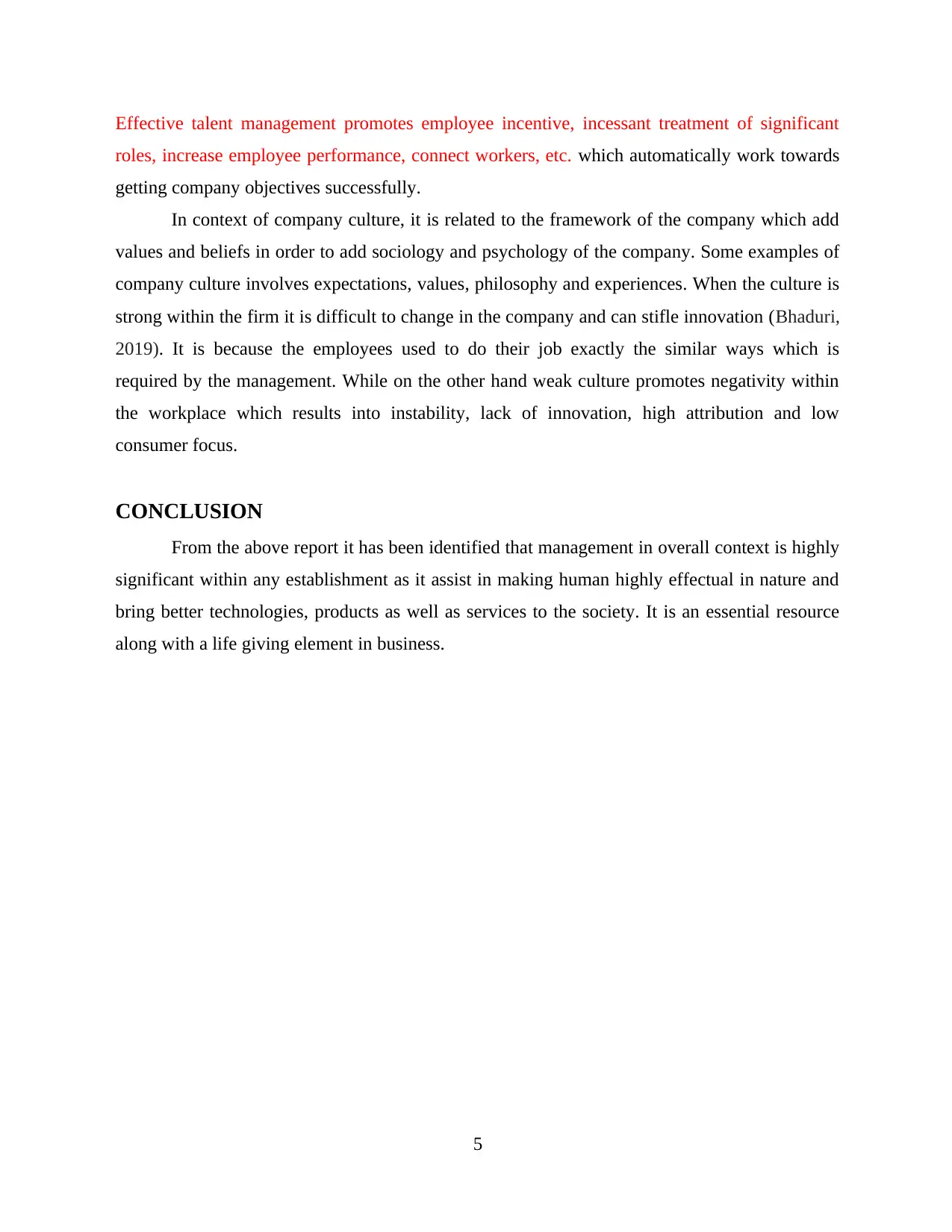
Effective talent management promotes employee incentive, incessant treatment of significant
roles, increase employee performance, connect workers, etc. which automatically work towards
getting company objectives successfully.
In context of company culture, it is related to the framework of the company which add
values and beliefs in order to add sociology and psychology of the company. Some examples of
company culture involves expectations, values, philosophy and experiences. When the culture is
strong within the firm it is difficult to change in the company and can stifle innovation (Bhaduri,
2019). It is because the employees used to do their job exactly the similar ways which is
required by the management. While on the other hand weak culture promotes negativity within
the workplace which results into instability, lack of innovation, high attribution and low
consumer focus.
CONCLUSION
From the above report it has been identified that management in overall context is highly
significant within any establishment as it assist in making human highly effectual in nature and
bring better technologies, products as well as services to the society. It is an essential resource
along with a life giving element in business.
5
roles, increase employee performance, connect workers, etc. which automatically work towards
getting company objectives successfully.
In context of company culture, it is related to the framework of the company which add
values and beliefs in order to add sociology and psychology of the company. Some examples of
company culture involves expectations, values, philosophy and experiences. When the culture is
strong within the firm it is difficult to change in the company and can stifle innovation (Bhaduri,
2019). It is because the employees used to do their job exactly the similar ways which is
required by the management. While on the other hand weak culture promotes negativity within
the workplace which results into instability, lack of innovation, high attribution and low
consumer focus.
CONCLUSION
From the above report it has been identified that management in overall context is highly
significant within any establishment as it assist in making human highly effectual in nature and
bring better technologies, products as well as services to the society. It is an essential resource
along with a life giving element in business.
5
Paraphrase This Document
Need a fresh take? Get an instant paraphrase of this document with our AI Paraphraser
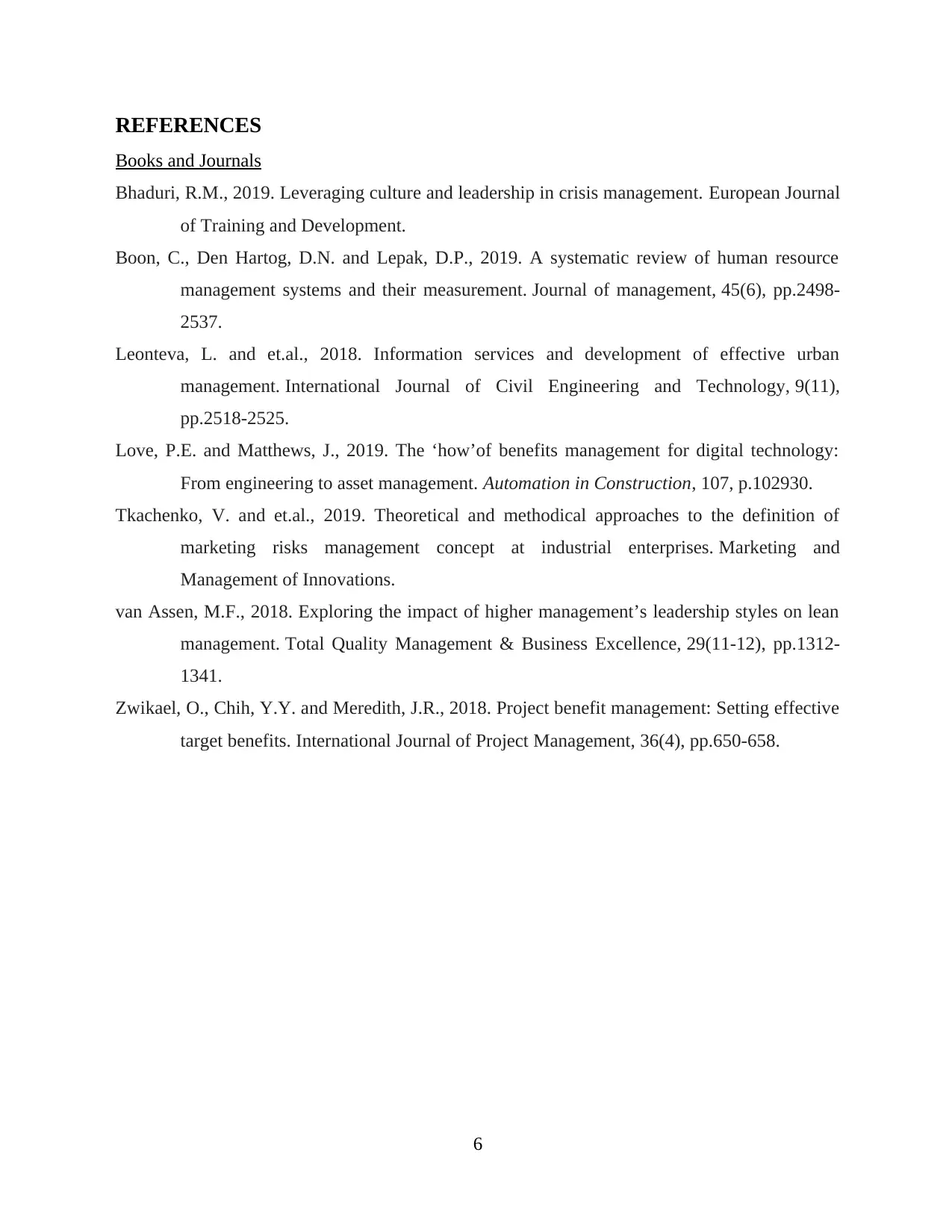
REFERENCES
Books and Journals
Bhaduri, R.M., 2019. Leveraging culture and leadership in crisis management. European Journal
of Training and Development.
Boon, C., Den Hartog, D.N. and Lepak, D.P., 2019. A systematic review of human resource
management systems and their measurement. Journal of management, 45(6), pp.2498-
2537.
Leonteva, L. and et.al., 2018. Information services and development of effective urban
management. International Journal of Civil Engineering and Technology, 9(11),
pp.2518-2525.
Love, P.E. and Matthews, J., 2019. The ‘how’of benefits management for digital technology:
From engineering to asset management. Automation in Construction, 107, p.102930.
Tkachenko, V. and et.al., 2019. Theoretical and methodical approaches to the definition of
marketing risks management concept at industrial enterprises. Marketing and
Management of Innovations.
van Assen, M.F., 2018. Exploring the impact of higher management’s leadership styles on lean
management. Total Quality Management & Business Excellence, 29(11-12), pp.1312-
1341.
Zwikael, O., Chih, Y.Y. and Meredith, J.R., 2018. Project benefit management: Setting effective
target benefits. International Journal of Project Management, 36(4), pp.650-658.
6
Books and Journals
Bhaduri, R.M., 2019. Leveraging culture and leadership in crisis management. European Journal
of Training and Development.
Boon, C., Den Hartog, D.N. and Lepak, D.P., 2019. A systematic review of human resource
management systems and their measurement. Journal of management, 45(6), pp.2498-
2537.
Leonteva, L. and et.al., 2018. Information services and development of effective urban
management. International Journal of Civil Engineering and Technology, 9(11),
pp.2518-2525.
Love, P.E. and Matthews, J., 2019. The ‘how’of benefits management for digital technology:
From engineering to asset management. Automation in Construction, 107, p.102930.
Tkachenko, V. and et.al., 2019. Theoretical and methodical approaches to the definition of
marketing risks management concept at industrial enterprises. Marketing and
Management of Innovations.
van Assen, M.F., 2018. Exploring the impact of higher management’s leadership styles on lean
management. Total Quality Management & Business Excellence, 29(11-12), pp.1312-
1341.
Zwikael, O., Chih, Y.Y. and Meredith, J.R., 2018. Project benefit management: Setting effective
target benefits. International Journal of Project Management, 36(4), pp.650-658.
6
1 out of 8
Related Documents
Your All-in-One AI-Powered Toolkit for Academic Success.
+13062052269
info@desklib.com
Available 24*7 on WhatsApp / Email
![[object Object]](/_next/static/media/star-bottom.7253800d.svg)
Unlock your academic potential
Copyright © 2020–2025 A2Z Services. All Rights Reserved. Developed and managed by ZUCOL.



